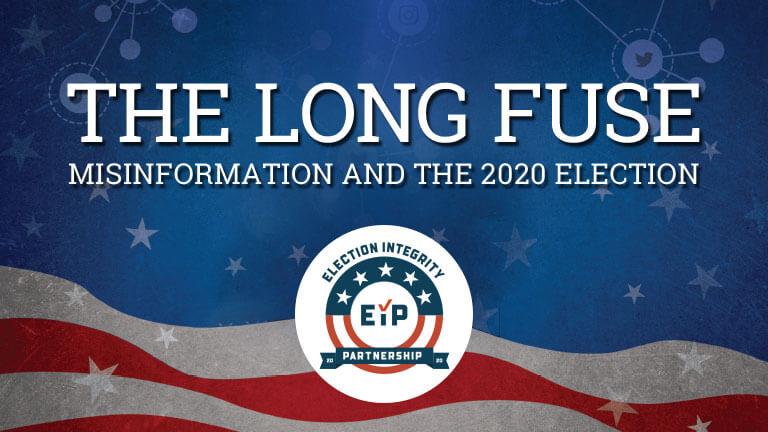Stanford Internet Observatory (SIO), the University of Washington’s Center for an Informed Public (CIP), Graphika, and the Atlantic Council’s Digital Forensic Research Lab (DFRLab) detail how misleading narratives and false claims about voting coalesced into the metanarrative of a “stolen election” which propelled the Jan. 6, 2021 insurrection at the U.S. Capitol.
Today, Graphika and our partners in the Election Integrity Partnership (EIP) have released the results of our months-long effort to collaboratively identify, track, and respond to voting-related mis- and disinformation during the 2020 U.S. elections, “The Long Fuse: Misinformation and the 2020 Elections.” Our partners from the Stanford Internet Observatory (SIO), the University of Washington’s Center for an Informed Public (CIP), and the Atlantic Council’s Digital Forensic Research Lab (DFRLab), will gather to discuss key findings, insights and recommendations from the final report during a virtual event hosted by The Atlantic Council on Wednesday, March 3 from 3-4:30 p.m. EST (12 noon-1:30 p.m. PST).
In November, we described how Graphika constructed a virtual Peace Room to conduct 24/7 monitoring of electoral disinformation. Over the course of its work, EIP partners focused on voting-related misinformation and the delegitimization of election results with three primary goals:
- Identifying mis- and disinformation before it went viral and during viral outbreaks
- Sharing clear, accurate counter messaging
- Increasing understanding of the dynamics shaping the information space during the 2020 election and its aftermath.
Misleading narratives and false claims about voting coalesced into the metanarrative of a “stolen election,” which propelled the Jan. 6, 2021 insurrection at the U.S. Capitol. The “Long Fuse” expands upon the coalition’s rapid-response research and policy analysis surrounding the November 2020 U.S. election, shedding light into the circumstances that amplified the “stolen election” narrative. The report includes a set of policy recommendations to describe how the unique model of the EIP may be expanded to combat future large scale misinformation events. Among key findings:
-
Misleading and false claims and narratives coalesced into the metanarrative of a “stolen election,” which later propelled the Jan. 6, 2021 insurrection.
-
Narrative spread was cross-platform: repeat spreaders leveraged the specific features of each platform for maximum amplification.
-
The primary repeat spreaders of false and misleading narratives were verified, blue-check accounts belonging to partisan media outlets, social media influencers, and political figures, including President Trump and his family.
-
Many platforms expanded their election-related policies during the 2020 election cycle. However, application of moderation policies was inconsistent or unclear.
The full copy of “The Long Fuse” is available on The EIP’s website. The 2020 election demonstrated that actors—both foreign and domestic—remain committed to weaponizing viral false and misleading narratives to undermine confidence in the U.S. electoral system and erode Americans’ faith in our democracy. Mis- and disinformation were pervasive throughout the campaign, the election, and its aftermath, spreading across all social platforms. The EIP was formed out of a recognition that the vulnerabilities in the current information environment require urgent collective action.
Please join us at Wednesday’s webinar, which is open to the public, but registering online here.
The event will begin with a fireside chat with Chris Krebs, the former director of the Department of Homeland Security’s Cybersecurity and Infrastructure Security Agency (CISA), who led the effort to secure electoral infrastructure and the response to mis- and disinformation during the election period. EIP Partners will discuss the origins and amplification of voting-related misinformation, the evolution of social platforms’ civic integrity policies and the effectiveness of their implementation, as well as how the EIP can serve as a model for future mis- and disinformation monitoring efforts.
Introductory Remarks
Graham Brookie
Director
DFRLab
Alex Stamos
Director
Stanford Internet Observatory
Fireside Chat
Chris Krebs
Founding Partner
Krebs Stamos Group LLC
Moderated by
Isabella Garcia-Camargo
Project Manager
Election Integrity Partnership
Presentation Featuring
Emerson Brooking
Resident Senior Fellow
DFRLab
Camille Francois
Chief Innovation Officer
Graphika
Renee DiResta
Research Manager
Stanford Internet Observatory
Kate Starbird
Associate Professor
Department of Human Centered Design and Engineering
University of Washington
Joe Bak-Coleman
Postdoctoral Scholar
Information School
University of Washington
Andrew Beers
Graduate Student
Human Centered Design & Engineering (HCDE)
University of Washington
Nicole Buckley
Research Analyst
School of Law
University of Washington
Alyssa Kann
Research Assistant
DFRLab
Ian Kennedy
Graduate Student
Sociology
University of Washington
Carly Miller
Research Analyst
Stanford Internet Observatory
Kyle Weiss
Research Analyst
Graphika
Moderated by
Alex Stamos
Director
Stanford Internet Observatory
